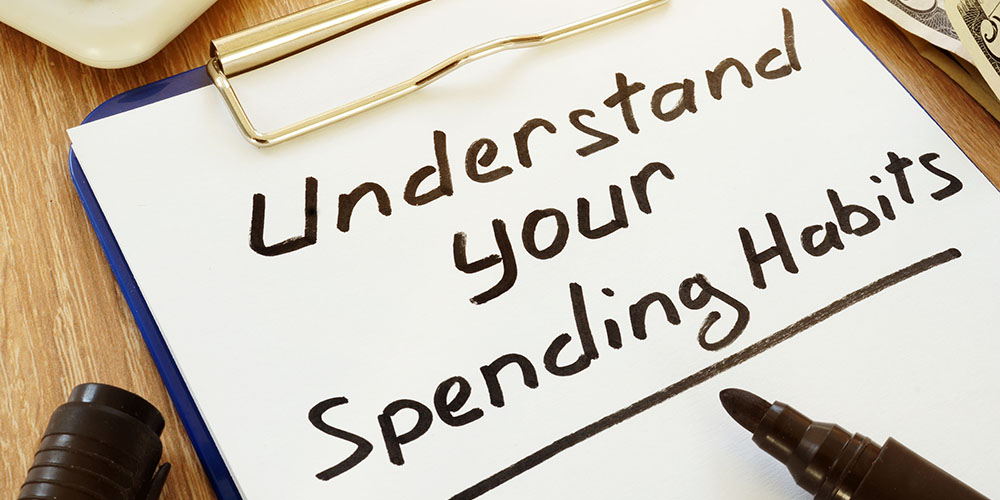Smart Spending 101

It goes without saying, spending money is a fact of life. We all need food, clothing, shelter, and transportation and that costs money. When we start spending too much, though, that’s when the trouble starts. For almost half of Americans, we’re spending more than we make each month. It doesn’t have to be this way. We can learn how to spend smart – and get better at saving – with just a few tweaks to our habits. Check out these simple steps to smart spending.
Step 1: Find Out How You Spend Money
When starting on your smart spending path, the very first step to take is to figure out how you, individually, spend money. Many of our spending habits are based on our emotions, whether we’re feeling flush, or even if we are bored. There are two parts to finding out how you spend money.
- Start by taking this spending quiz. While there are many options, this particular quiz will help you work through big, small, and every day money decisions to help you determine your relationship with money.
- Review your receipts. Walking into the store without a list often spells disaster for our wallets. Sometimes, though, a list can’t help prevent us from buying extra items. At the end of each week, reviewing your receipts will help you understand what it is you’re spending money on, whether that’s necessities or extras. This will give you an idea of what’s taking up so much of your income each week.
Step 2: Start By Focusing on One Spending Habit
We are all unique and therefore have unique spending habits. Some of us don’t mind buying a Starbucks latte every morning while others prefer to fill up at home. You’ll find what your biggest spending habits include by looking at your receipts and bank statements and adding up the costs based on the type of purchase made. But taking a look at what the average American spends their money on can also help you figure out where you need to focus. Here’s a list of buckets that we typically pour most of our funds into:
- Eating food away from home
- Too much house for too small a budget
- Too much car for too small a budget
- Overspending on your children or pets and other entertainment
For some of us, housing costs can’t be avoided – especially if we live in expensive cities. But there are other areas we can look to improve, starting with this next step.
Step 3: Instill Healthy Spending Habits
Now that you have a better idea of what kind of spender you are and in what areas you may be spending a bit too much, the next step is to create healthy habits instead. This doesn’t mean you’re quitting cold turkey; it just means you’re making a swap, of sorts. Over time, these habits will become second nature, which can then snowball into more healthy spending habits. EveryDollar has some great tips to getting started:
Keep the End Goal in Mind
When we don’t have a solid reason, or goal, for changing spending habits – such as saving money for a security net – it can get tricky to stay on target. By creating daily, weekly, monthly, and even yearly goals, we can get immediate satisfaction from reaching our target and keep the bigger picture in mind. For many, this can mean creating a budget, so you have a better idea of what you have to spend.
Focus on Debt
Have you ever experienced the weight of the world lift off your shoulders after you have made your final payment to pay off a loan? Not only is it a freeing feeling, but it feels even better knowing that you now own what you are paying off outright. Whether that’s a car, home, or even student loan, paying off a loan can offer you an even bigger boost of happiness than an impulse buy – and keep boosting you each month you no longer have to make that payment.
Accountability and Avoidance
Many caution against avoidance, as it often results in bigger problems than facing it head-on. This is not the case with spending triggers. If there’s a store that you know is your kryptonite, avoid going inside as much as possible. If you can’t, this is where an accountability partner comes into play. Take someone with you on your next trip to your favorite store and allow them to control what goes into the cart and makes it to checkout.
Use Time and Distance to Your Advantage
Whether you struggle with impulse buys, go crazy over sales, or pay little attention to the individual cost of everyday items, time and distance can become your best friend. When you see a product, take the time to research the item, try to find better deals, and consider all the ways it will be useful to you beyond the thrill of purchase.
Give Yourself Allowance
There is nothing harder to stick to than a budget that allows you zero wiggle room. Put aside money each week that is just for you to play with, however you want, without guilt or shame. This “fun” money may very well be exactly what you need to avoid binge buying.
Get Cash from a LendNation Loan
Remember, no matter what your spending habits look like, you aren’t alone! We all could take the time to sit down and examine our spending habits, how we save money, and whether or not we are prioritizing to pay off loans. As you get back on track to healthier spending, look to LendNation for your emergency cash needs. Whether you need a title loan, installment loan or payday loan, LendNation can help you get through to the other side of smart spending. Learn more or start your application now.